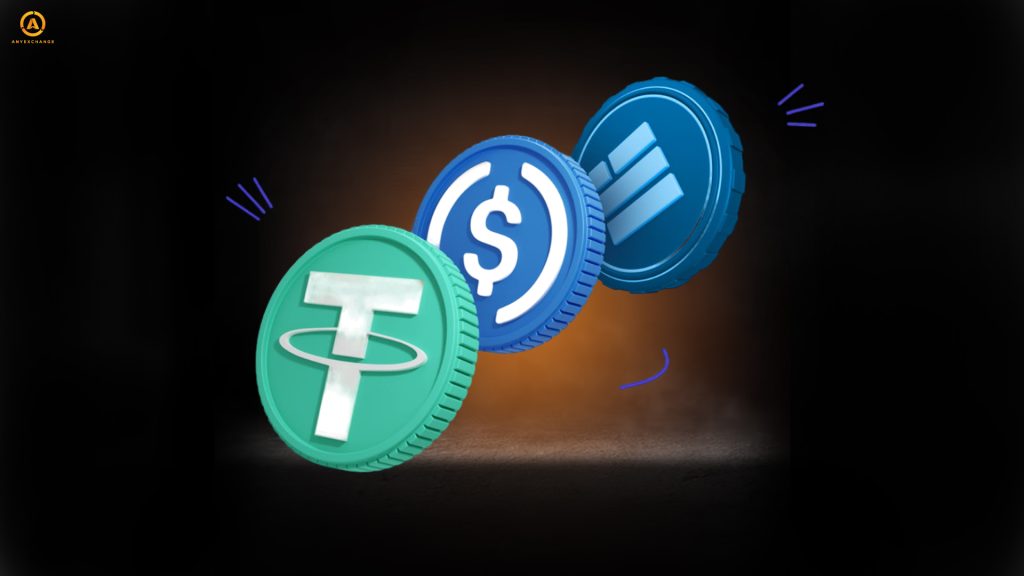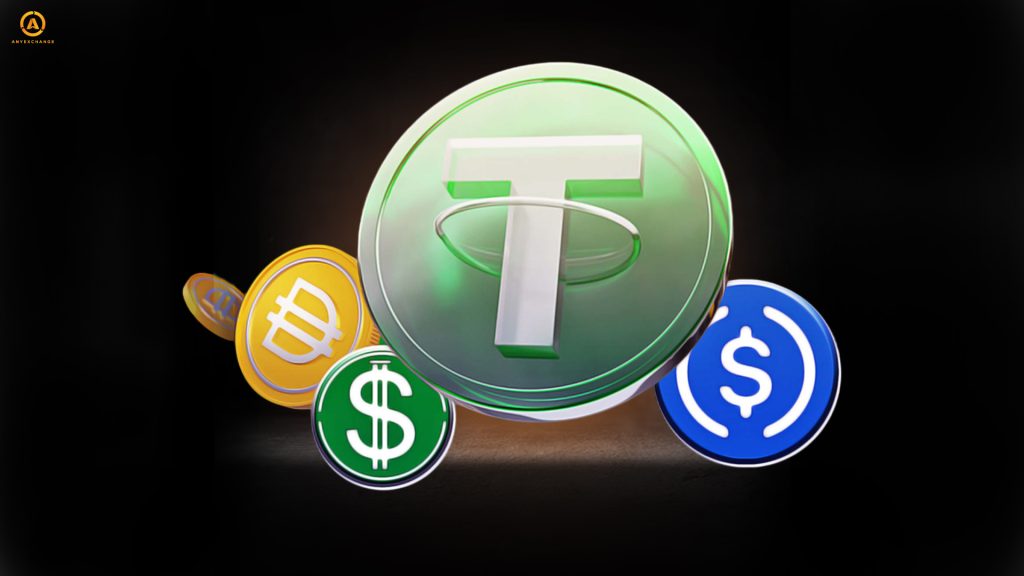
Stablecoins are a kind of bridge between the traditional financial market and the decentralized one. Being linked to fiat currencies and backed by reserves, they are more trustworthy and easier to adapt to the norms of current financial legislation. This is why the regulation of stablecoins is being implemented in the first place, as stablecoins as a means of payment are the most organic cryptocurrency asset for classical financial systems.
Let’s understand what is the essence of this asset, what is its importance for the global economy and what are the prospects for its development.
“Stablecoins are digital assets whose price is stabilized by pegging it to a fiat currency or other valuable asset (for example, gold or oil). This means that the price of a cryptocurrency, which by nature has a high volatility, becomes more stable”.
Stablecoins and the cryptocurrency market
Stablecoins have emerged as a tool to balance the crypto market. Digital assets with a stable exchange rate offset the sector’s overall volatility and served as a link to the traditional financial systеm.
The cryptocurrency market began by trading bitcoin, common altcoins, and native project tokens paired with fiat. And traders had to exit cryptocurrency into fiat using centralized exchanges to lock in profits, which took time. And initially, stablecoins were created precisely to reduce trader risk during periods of high volatility: professional market participants needed the ability to quickly transfer assets into a stable currency without intermediaries.
Tether USDT, pegged 1:1 to the U.S. dollar and issued by Tether Holdings Limited in 2014, and all subsequent stablecoins have successfully solved the original task. In addition, their emergence stimulates the market as a whole, reducing overall volatility and creating conditions for:
Use for risk management in the diversification of investment portfolios;
Developing the DeFi sector by creating mechanisms with minimal risks to attract investors;
wider use of cryptocurrencies in payments (in particular, the role of stablecoins in international remittances is tangible)
Increasing access to global financial markets (including countries where access to banking services is limited)
Increasing market liquidity (stablecoins appear in the majority of exchange pairs on CEX and DEX).
The most important stablecoin on the market
USDT is a stablecoin issued by Tether, a company registered in Hong Kong. At the time of writing, Tether USDT is the third largest circulating cryptocurrency in the world by market capitalization. The company states that each USDT coin issued is backed by a USD asset equivalent or higher in order to maintain a fixed exchange rate. USDT reserves consist of cash, treasury bills and other investment products.
USDC is a stablecoin issued by the US company Circle and is a major competitor to USDT. It is positioned as a transparent and regulated asset that undergoes regular financial validation. According to the issuer, all coins are backed by USD reserves or other “approved investments”. Ranked as the second most capitalized stablecoin in the world.
MakerDAO’s Ethereum-based DAI is the third most capitalized stablecoin in the world and differs from USDT and USDC in its collateral mechanism. In it, reserves are formed by participants’ pledges of cryptocurrency, which they deposit in exchange for DAI. The exchange rate of the coin is stabilized in a USD peg by smart contracts that automatically manage the reserves: if the price of the stablecoin falls, they reduce the amount of DAI in circulation, and vice versa. DAI is a prime example of an over-collateralized decentralized stablecoin, and its flexibility is a key differentiator from its centralized competitors USDT and USDC. Overcollateralization means that the value of the cryptocurrency deposited as collateral must be greater than the value of the DAI (MakerDAO provides different collateral standards for different cryptocurrencies).
Types of Stablecoins

By the value of the peg
They can be pegged to either a fiat currency rate or the value of a precious metal. Other types of pegging (to minerals, etc.) have not yet found practical application.
The vast majority of stable coins are pegged to the USD, followed by EUR, GBP, and other currencies on a downward trend. In December 2023, Emittance Corporation announced the release of the first Ukrainian UAHg stablecoin, pegged to the UAH at a 1:1 ratio.
As for “gold” stablecoins, they make up no more than 0.8% of the stablecoin market. The most prominent examples of such assets are PAX Gold (PAXG) and Tether Gold (XAUT), whose price is pegged to the price of a troy ounce of gold.
By Collateralization
Stablecoins can be backed by fiat currencies, precious metals and other assets. Here we distinguish between fiat, cryptocurrency, commodity and cryptocurrency stablecoins. Fiat ones are backed by reserves of cash or electronic money, cryptocurrency ones by digital assets, commodity ones by precious metals or securities. There is also a class of unsecured coins that operate solely on algorithms.
By management
Centralized stablecoins are managed by the issuing company, while decentralized ones are managed by the community.
Centralized management means that a single company or group is obligated to issue the stablecoins and maintain sufficient reserves to redeem the entire issue if necessary. Thus, an investor who buys one coin for one dollar can expect to be able to sell it back to the issuer at the same rate in the future. This systеm requires trust in the issuer, who must confirm adequate reserves through regular independent audits. Stablecoins of this type are the vast majority.
Decentralized administration is based on the use of algorithms, hence the name “algorithmic”. Algorithmic coins operate without an issuer, their value is maintained automatically using mathematical algorithms and smart contracts. They don’t require traditional fiat reserves and work either by collateralizing cryptocurrency assets or without them. The idea behind their creation was to move away from centralized principles where the collateralization and circulation of an asset is concentrated in one decision center. They are actively used in DeFi as a decentralized way for stablecoins to maintain value. After the collapse of $UST in the context of the Terra crisis in 2022, investors lost some confidence in such a governance model, but the steady development of DAI has allayed market fears. A similar mechanism is used for Ampleforth (AMPL), Frax (FRAX) and Dynamic Set Dollar (DSD).
Advantages of Stablecoins
Price stability. The impact of stablecoins on the financial stability of investors and the crypto market as a whole is that this type of asset is an ideal way to store, hedge volatility and diversify capital. The global economy goes through cyclical crises, and stablecoins serve as one of the tools to combat destabilization.
Low cost and high transaction speed. The advantages of stablecoins in transactions inсlude significantly lower fees and faster financial transactions compared to traditional bank payments and money transfers. The comparison of stablecoins and traditional currencies on these parameters is clearly not in favor of the latter.
High liquidity. Guarantees by the issuer that the price of the token is tied to one or another asset make it possible to sell the token at any time at the price of the original asset. The multichain nature of stablecoins (they are usually launched simultaneously on multiple networks) and their free availability on CEX and DEX also provide ample opportunities for traders and investors. Stablecoins and decentralized finance (DeFi) have been working together since the first stablecoin was created.
Regulability. The legal aspects of stablecoins imply a more transparent regulation compared to other types of cryptocurrencies, as the issuer of a stablecoin must operate legally. This aspect increases trust in terms of user protection and is key for institutional investors.
Challenges of using stablecoins
Issuer risks or algorithmic vulnerabilities. Tether has the lion’s share of the market, but no one is immune to the company going bankrupt and not being able to redeem tokens from owners. The auditing and transparency of stablecoins, on which, for example, the USDC issuer relies, can also be questioned. Also, the algorithms that control the issuance and circulation of tokens may not be efficient, creating the risk of depegging or even collapsing of the coin.
Censorship as the downside of regulatability. As regulators fight money laundering and other criminal activities, the risk of transactions being traced, users being de-anonymized, and funds being blocked is quite high. Investors may not like this. By the way, the absence of this problem is precisely the strength of decentralized stablecoins, which are much less dependent on regulators than centralized ones.
Risks of decoupling the price of a stablecoin from the underlying asset (depegs). According to Moody’s, there were 609 depegs in 2023, when large-capitalization stablecoins lost their peg to the exchange rate of the underlying currency. One high-profile case was when a trader lost $529,000 due to the automatic liquidation of USDC tokens as a result of the USDP (Pax Dollar) jumping to $1.18.
The market situation and the future of stablecoins in the economy

The U.S. is currently negotiating another bill to regulate stackable coins. The debate about “tightening the screws” and creating additional regulatory barriers for the industry continues unabated. The outcome of this debate could have a significant impact on stackable coin innovation and the development of stackable coins globally.
At the same time, stablecoins and the banking sector continue to forge reciprocal relationships for cross-border payments. The integration of stablecoins into payment systems is also progressing. In particular, PayPal recently launched its own dollar-based stablecoin, PYUSD, to facilitate money transfers and international payments.
More broadly, stablecoin capitalization reached a two-year high at the end of Q1 2024, surpassing $160 billion. The number of stablecoin holders has also reached a record high, confidently approaching 100 million. At the same time, USDT, which holds a strong position as the segment leader, accounts for approximately 70% of the market. Over the past year, its share has increased by 20% (mainly due to a decrease in USDC’s share as a result of the depeg caused by the collapse of Silicon Valley Bank).
To date, the risks of Tether and USDC stablecoins lie mainly in the uncertainty of legislation, the passage of which the industry is eagerly awaiting.
Thank you for reading our article. Invest safely and profitably!
AnyExchange is an exchanger that allows you to quickly and anonymously convert cryptocurrency into electronic or cash at the best exchange rate . Worldwide money transfers are also available on our platform.








